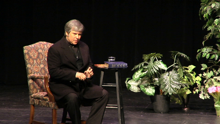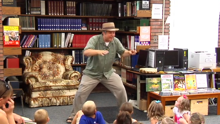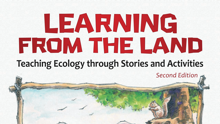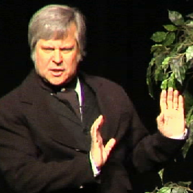By Brian “Fox” Ellis
We recently purchased a new home on the north side of Peoria and one of the first things I did was plow up a large portion of the front yard and plant a perennial garden of mostly red, orange and pink flowers.
I am not sure what the neighbors thought. I can only hope they were pleased when, a few months later, there were a dazzling array of gorgeous blossoms and the added delight of monarch butterflies and ruby throated hummingbirds. Winged jewels fluttered and buzzed about attracting all of the neighborhood kids to our front yard.
My daughters were sometimes eager and sometimes reluctant to help, but the pay off came rather quickly. There were three new activities that kept my girls outside and away from the TV all summer long!
A Miracle in the Making
The neighborhood kids would sit on a stepping stone in the garden, very still and surprisingly silent, waiting for a hummingbird to come buzzing in to a feeder. After I saw this was a favorite activity, I adjusted the height of one of the hummingbird feeders so the birds were at eye level for a quiet bird watcher. The joy on their faces when a hummingbird was inches away, or better yet, landed on their shoulder, made all of the work worth while! They quickly learned that wearing bright red helped attract the hummingbirds.
Another favorite pastime was the game of chase the butterfly. On some sunny days there would be several species sipping nectar from whichever flowers were blooming. With nets in hand the kids would see how many butterflies they could catch in a mad dash. With a simple field guide to Butterflies they would see how many they could identify and then turn them all loose. We emphasized the idea that one should never harm such a beautiful creature. My daughters have become self taught lepidopterists; I have learned quite a bit about the nature of our local fritillary from my children, including the words lepidopterists and fritillary!
Their favorite activity, that consumed weeks of patient watching and daily checking, was nurturing freshly laid eggs through the process of metamorphosis. Truth is we did nothing beyond planting the host species of plants, but watching caterpillars grow became a wondrous obsession. We have seen butterflies mate in a clumsy yet graceful flight. We have seen the eggs being laid. We love watching caterpillars chomp, chomp, chomp, devouring entire leaves. But the true magic comes when you see a chrysalis open. We have watched the butterfly pump fluid into her wings and then rest while they dried. Soon afterward they stretched their new wings and then took their first flight. The whole neighborhood stopped whatever they were doing to be a part of this miracle of nature.
How Can You Bring These Winged Jewels to Your Yard?
I chose the location, full sun is best, partial shade is tolerable. We have a southeast facing section right in front of a picture window, near the driveway and sidewalk, so the garden can be enjoyed everyday, both inside and out.
I wanted my daughters to help and to invest in the project from the ground up so I involved them from the beginning.
I asked the girls what kinds of flowers they wanted. Since my daughters are named Laurel and Lily we included both of these. With my wife, we leafed through a catalog of perennial flowers. We chose a number of red tubular flowers to attract hummingbirds. For butterflies it is trickier, we needed both nectar for the adults and the right kinds of host plants for the caterpillars. Each species will only lay eggs on certain plants: monarch on milkweed, sulfur on cabbage, and swallowtails on the carrot family, including dill and parsley. (Most garden shops have posters with this kind of information or you could visit some of the web links at the end of the article.)
With the layout of the garden there were several goals: First, I wanted a layered look with shorter flowers up front and taller ones towards the back, but none so tall that they blocked the window. I also wanted something to be blooming in all three seasons, spring, summer and fall. I wanted a variety of leaf shapes and shades of green for visual variety when plants were not blooming. And as a special treat we planted a few species of mints, edible flowers, ever-blooming strawberries and culinary herbs. This added multi-sensory delight for the kids and flavor for the kitchen. Some species of butterflies also lay their eggs on mints and herbs. Again, most nurseries, garden catalogs and several web pages have a wealth of information about blooming cycles and flower heights.
The only imperative for encouraging local butterflies and hummingbirds is to plant local species. Native prairie perennials are essential to attracting native insects and birds. Native wildflowers are also more drought tolerant, heat resistant, and they live longer with less care or fuss once they are established.
The Real Work Begins
We purchased some plants through catalogs, some from local nurseries and we also borrowed or traded cuttings from the neighbors’ yards. Most perennials need to be thinned or cut back every few years and most earnest gardeners are willing, nay, eager to share their bounty.
When the girls were little we bought toy garden implements, which I would not recommend. They break easily and are useless as tools. Many garden stores stock smaller shovels and hand trowels just right for smaller hands, yet sturdy enough for real work.
The girls especially enjoyed planting larger potted flowers that were already blooming. Everyone loves immediate gratification. I would dig the holes, to make sure they were the right depth and the right location, and they would put the flowers in the ground, the easy and rewarding part of the job. One little mystery that they loved was planting bulbs “where ever they wanted” so that it would be a surprise in the spring. They also enjoyed playing with the hose, uhm, watering the plants.
I let them decide where to put the stepping stones. For a fun craft project we actually went the extra mile and made our own mosaic stepping stones, a time consuming project that is completely unnecessary, but a load of fun.
We purchased both large and small metal shepherds crooks to hang our hummingbird feeders. We found out the hard way that some of the smaller, inexpensive plastic feeders actually work better than some of the large fancy glass ones. Because you need to change the sugar water regularly, you do not want large reservoirs for the nectar. You can purchase nectar OR cheaply and easily make your own by adding 1 cup of white cane sugar to 4 cups of water. Do not add red dye; a red container is enough to attract hummingbirds. Store it in the refrigerator for up to two weeks to make easier to refill feeders. The only hassle is that it is important to wash and sterilize the feeders every few days to keep down the risk of deadly bacteria growing in the nectar.
After everything was planted and the feeders were up, we applied a heavy woodchip mulch to keep the weeds down and the moisture in so there is very little need for maintenance. In our second season we planted a few new species of flowers to thicken up a weak spot and round out our blooming cycles. We have learned to rotate hummingbird feeders in the summer with regular bird feeders in the winter. And we added more milkweed species for the monarchs, our favorite butterfly.
This spring, we look forward to attempting something we recently read about but have never tried: finding a hummingbird nest. They are smaller than a gold dollar and made of lichen and moss, held together with spiders’ webs. The trick to finding one is to use an old honey gathering technique. Like a bee line, hummers often fly from their nectar source straight back to their nest. They zip off quickly and, according to a friend who has had great success, you can only follow them a short way each time. But with patience, each time they return from the feeder to the nest you can follow them a little further until you see their hiding spot.
When the monarch returns from its winter migration to Mexico and the ruby-throated hummers gather spider webs for their nests, we will relish knowing that what has brought us such great joy has also made a difference in the population of local butterflies and hummingbirds.
Recommended Web Pages and Books for planning and planting your own Butterfly/Hummingbird Garden:
The Family Butterfly Book by Rick Mikula. This activity book includes projects, activities, and a field guide to 40 favorite North American species. Rick explains how to identify, care for, and raise butterflies in your own backyard, whether you live in an urban or rural setting. ISBN# 1-58017-292-X
The Prince of Butterflies by Bruce Colville, Illustrated by John Clapp. This delightful children’s picture tells the miraculous story of a butterfly migration and the lives it touches. It also highlights the plight of migrating monarchs and still makes me cry when I read it... yet there is great hope in its pages! ISBN # 0-15-201454-3
Familiar Butterflies, The Audubon Society Pocket Guides. These handy guides are great for children and adults. They have beautiful full color photographs of 80 species. The guide book includes information about host plants, range and habitat. ISBN # 0-679-72981-X









